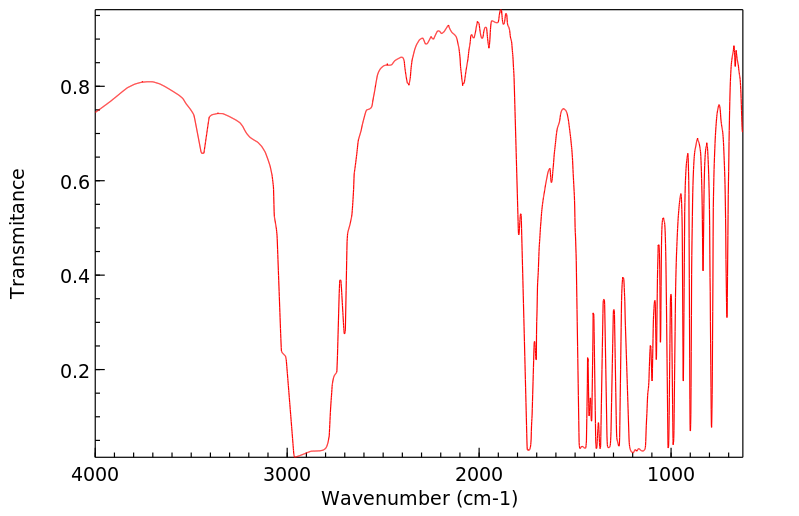哌嗪-1,4-二丙酸二甲酯 | 4038-90-8
中文名称
哌嗪-1,4-二丙酸二甲酯
中文别名
——
英文名称
3-[4-(2-methoxycarbonylethyl)piperazin-1-yl]propionic acid methyl ester
英文别名
piperazine-1,4-dipropanoic acid dimethyl ester;1,4-Bis[2-(methoxycarbonyl)ethyl]piperazine;1,4-bis(2-methoxycarbonylmethyl)piperazine;3,3'-piperazine-1,4-diyl-bis-propionic acid dimethyl ester;1,4-piperazinedipropanoic acid, dimethyl ester;dimethyl piperazine-1,4-dipropionate;methyl 3-[4-(3-methoxy-3-oxopropyl)piperazin-1-yl]propanoate
CAS
4038-90-8
化学式
C12H22N2O4
mdl
MFCD00130197
分子量
258.318
InChiKey
ZNYIVYFFZCEWDY-UHFFFAOYSA-N
BEILSTEIN
——
EINECS
——
-
物化性质
-
计算性质
-
ADMET
-
安全信息
-
SDS
-
制备方法与用途
-
上下游信息
-
文献信息
-
表征谱图
-
同类化合物
-
相关功能分类
-
相关结构分类
物化性质
-
熔点:55-56 °C(Solv: heptane (142-82-5))
-
沸点:155 °C(Press: 3 Torr)
-
密度:1.091±0.06 g/cm3(Predicted)
计算性质
-
辛醇/水分配系数(LogP):-0.3
-
重原子数:18
-
可旋转键数:8
-
环数:1.0
-
sp3杂化的碳原子比例:0.833
-
拓扑面积:59.1
-
氢给体数:0
-
氢受体数:6
安全信息
-
海关编码:2933599090
SDS
上下游信息
-
下游产品
中文名称 英文名称 CAS号 化学式 分子量 —— 3,3'-(piperazine-1,4-diyl)bis(propan-1-ol) 28765-60-8 C10H22N2O2 202.297
反应信息
-
作为反应物:描述:哌嗪-1,4-二丙酸二甲酯 在 lithium aluminium tetrahydride 作用下, 以 乙醚 为溶剂, 反应 3.0h, 以72%的产率得到3,3'-(piperazine-1,4-diyl)bis(propan-1-ol)参考文献:名称:Kafka, Stanislav; Cermak, Jan; Novak, Tomas, Collection of Czechoslovak Chemical Communications, 1985, vol. 50, # 5, p. 1201 - 1211摘要:DOI:
-
作为产物:描述:哌嗪 、 丙烯酸甲酯(MA) 在 bismuth(lll) trifluoromethanesulfonate 作用下, 以 乙腈 为溶剂, 反应 1.0h, 以95%的产率得到哌嗪-1,4-二丙酸二甲酯参考文献:名称:Chemoselective Michael TypeAddition of Aliphatic Amines to α,β-Ethylenic CompoundsUsing Bismuth Triflate Catalyst摘要:三氟甲磺酸铋的催化量在温和条件下能高效催化脂肪胺与α,β-乙烯基化合物在乙腈中的迈克尔加成反应。该反应具有化学选择性,因为芳香胺不参与反应。此外,催化剂易于回收和重复使用。DOI:10.1055/s-2003-38345
文献信息
-
Silicon Carbide Passive Heating Elements in Microwave-Assisted Organic Synthesis作者:Jennifer M. Kremsner、C. Oliver KappeDOI:10.1021/jo060692v日期:2006.6.1Microwave-assisted organic synthesis in nonpolar solvents is investigated utilizing cylinders of sintered silicon carbide (SiC)a chemically inert and strongly microwave absorbing materialas passive heating elements (PHEs). These heating inserts absorb microwave energy and subsequently transfer the generated thermal energy via conduction phenomena to the reaction mixture. The use of passive heating利用化学惰性和强微波吸收材料烧结碳化硅(SiC)的圆柱体研究了非极性溶剂中的微波辅助有机合成作为被动加热元件(PHE)。这些加热插件吸收微波能量,然后通过传导现象将产生的热能转移到反应混合物中。通过使用无源加热元件,可以在密封容器微波条件下将微波透明或吸收不良的溶剂(例如己烷,四氯化碳,四氢呋喃,二恶烷或甲苯)有效地加热到远高于其沸点(200-250°C)的温度。这证明了在非极性溶剂环境中进行微波合成的可能性,这已成功证明了几种有机转化,例如克莱森重排,狄尔斯-阿尔德反应,迈克尔加成,N-烷基化和Dimroth重排。在由于离子液体与特定底物不相容而无法增加反应介质的微波吸收率的其他选择(例如添加离子液体作为加热助剂)不可行的情况下,这种非侵入性技术是一种特别有价值的工具。SiC加热元件具有1500°C的耐热和化学耐受性,并且与任何溶剂或试剂兼容。
-
Cu(acac)2 Immobilized in Ionic Liquids: A Recoverable and Reusable Catalytic System for Aza-Michael Reactions作者:M. Lakshmi Kantam、V. Neeraja、B. Kavita、B. Neelima、Mihir K. Chaudhuri、Sahid HussainDOI:10.1002/adsc.200404361日期:2005.5Copper(II) acetylacetonate immobilized in ionic liquids efficiently catalyzes the aza-Michael reaction of amines with α,β-unsaturated carbonyl compounds to produce the corresponding β-amino carbonyl compounds with great alacrity in excellent yields. The reactions are far more facile than those reported earlier. The recovered ionic liquid phase containing the copper catalyst can be reused for several cycles
-
Cellulose-Supported Copper(0) Catalyst for Aza-Michael Addition作者:K. Reddy、Nadakudity KumarDOI:10.1055/s-2006-949623日期:2006.9Cellulose-supported copper(0) efficiently catalyzes the aza-Michael reaction of N-nucleophiles, such as amines and imidazoles with α,β-unsaturated compounds to produce the corresponding β-amino compounds and N-substituted imidazoles in excellent yields. The reactions are facile and the recovered catalyst is used for several cycles with consistent activity.
-
Electrochemical fluorination of several 1,4-bis[(methoxycarbonyl)alkyl] substituted piperazines作者:Takashi Abe、Hajime Baba、Irina SoloshonokDOI:10.1016/s0022-1139(01)00357-8日期:2001.5Four piperazines, having bis[(methoxycarbonyl)alkyl] groups (CH2CH2C(O)OMe (1), CH(CH3)C(O)OMe (2), CH2CH(CH3)C(O)OMe (3) and CH(CH3)CH2C(O)OMe (4) at the 1- and 4-positions of the piperazine ring), were subjected to electrochemical fluorination (ECF). Two bis[(methoxycarbonyl)alkyl] derivatives of N,N′-dimethylethylenediamine (molecular formulae: MeO(O)CH2CH2N(CH3)CH2CH2N(CH3)CH2CH2C(O)OMe (5)四个哌嗪,具有双[(甲氧基羰基)烷基]基团(CH 2 CH 2 C(O)OME(1),CH(CH 3)C(O)OME(2),CH 2 CH(CH 3)对C(O)OMe(3)和CH(CH 3)CH 2 C(O)OMe(4)在哌嗪环的1和4位进行电化学氟化(ECF)。N,N'-二甲基乙二胺的两个双[(甲氧羰基)烷基]衍生物(分子式:MeO(O)CH 2 CH 2 N(CH 3)CH 2 CH 2 N(CH 3)CH 2 CH 2 C(O)OMe(5)和MeO(O)CH(CH 3)CH 2 N(CH 3)CH 2 CH 2 N(CH 3)CH 2 CH(CH 3)C(O) OMe](6))也进行了类似的氟化以用于比较研究。上哌嗪衍生物(ECF的1 - 4),[全氟烷基(氟羰基)]形成基团具有双相应perfluoropiperazines,而底物的ECF 5和6仅提供降解的产品。含有全氟哌
-
STRUCTURE OF ADJUSTABLE STERIC HINDRANCE WEAK BASIC LIGHT STABILIZER AND PREPARATION METHOD AND APPLICATION THEREOF申请人:Shaoxing Ruikang Biotechnologies Co., Inc公开号:US20220145045A1公开(公告)日:2022-05-12The field of new compounds and synthesis methods thereof are related, and particularly to a structure of a steric hindrance adjustable weak base light stabilizer and a preparation method and application thereof. According to the innovative light stabilizer, a steric hindrance thereof is adjusted by establishing substituent generating the steric hindrance around nitrogen atoms; moreover, an electronegativity of the nitrogen atom can be influenced by adjusting a distance of a polar group, so that an alkalinity or a nucleophilicity of the nitrogen atom is adjusted. A desired effect is obtained by adjusting a steric hindrance and a nucleophilic property or an alkalinity where the nitrogen atom is located, so that an application range of the innovative light stabilizer is widened, and the innovative light stabilizer is suitable for PC, polyester, PVC and other slightly acidic or certain electrophilic polymer materials to serve as a light stability protecting aid.
表征谱图
-
氢谱1HNMR
-
质谱MS
-
碳谱13CNMR
-
红外IR
-
拉曼Raman
-
峰位数据
-
峰位匹配
-
表征信息
同类化合物
(2S)-4-[7-(8-氯-1-萘)-5,6,7,8-四氢-2-[[((2S)-1-甲基-2-吡咯烷基]甲氧基]吡啶基[3,4-d]嘧啶-4-基]-1-(2-氟-1-氧代-2-丙烯-1-基)-2-哌Chemicalbook嗪乙腈;2-((S)-4-(7-(8-氯萘-1-基)-2-((((S)-1-
齐拉西酮相关物质C
齐拉西酮杂质E
齐拉西酮开环物,氨基酸杂质
齐拉西酮亚砜
齐拉西酮 盐酸盐 一水合物
齐拉西酮
鲸蜡硬脂醇
鲁拉西酮杂质3
鲁拉西酮杂质23
鲁拉西酮杂质14
鲁拉西酮杂质11
鲁拉西酮
鲁拉西杂质E
鲁拉西杂质1
高分子量聚合三嗪类无卤阻燃剂
驱虫灵D
马福拉嗪
马来酸阿伐曲泊帕
顺式-1-乙酰基-2,6-二甲基-4-亚硝基-哌嗪
雷诺嗪双(N-氧化物)
陶扎色替
阿达色林
阿莫西林二氧代哌嗪
阿立哌唑羟基丁基杂质
阿立哌唑杂质26
阿立哌唑USP相关物质H
阿立哌唑N4-氧化物
阿立哌唑N,N-二氧化物
阿立哌唑EP杂质D
阿立哌唑-d8
阿立哌唑
阿泊替尼
阿替韦啶
阿拉诺丁
阿扎哌醇
阿得巴司
阿尔哌汀
阿伐曲泊帕杂质
间羟基苯基哌嗪
钾 1-甲基-4-三氟硼酸三甲基哌嗪
钠4-(4-乙酰基-1-哌嗪基)苯酚
酮齐拉西酮
酮酮唑油酸酯
酚酞单磷酸酯二-(2-氨基-2-甲基-1,3-丙二醇)盐
选择性氟试剂II
达鲁舍替
达哌唑
赫普索
赤霉素A7甲酯







